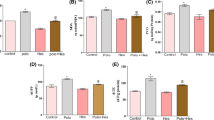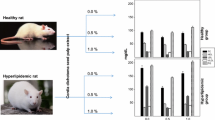Abstract
Moringa peregrina (M. peregrina) is a native species of Southwest Asia used to prepare traditional foods which have a wide range of antioxidants that can prevent metabolic disorders. The great interest has focused on the preparation and administration of herbal products to treat hyperlipidemia with fewer or no side effects along with economic and easy availability compared to conventional drugs. This study aimed to assess the lipid-lowering and antioxidant effects of aqueous ethanolic extract of M. peregrina leaves on fatty liver disease (NAFLD) model in rabbits as well as morphological changes, cytotoxic, and anti-lipid peroxidation effects of M. peregrine leaf extract (MPLE) on human umbilical vein endothelial cells (HUVECs) in vitro. Thirty-two adult male rabbits received a standard diet or a high-fat diet (HFD) for 112 days. During days 56–112, the standard diet group received normal saline, and the HFD groups received normal saline, M. peregrina extract (200 mg/kg body weight) orally by gavage, or simvastatin (0.6 mg/kg body weight) orally by gavage. Lipid profile, glutathione content, antioxidant enzymes, lipid peroxidation, blood urea nitrogen (BUN), creatinine, alanine aminotransferase (ALT) and aspartate aminotransferase (AST), and liver histology were assessed. The morphological changes, cytotoxic, and anti-lipid peroxidation effects of MPLE were evaluated on HUVECs. Administration of MPLE and simvastatin alone improved the high-fat diet-induced dyslipidemia and lipid peroxidation in HFD rabbits. The results also showed that MPLE and simvastatin significantly decreased body weight, tissue and cellular malondialdehyde (MDA) content, and serum tumor necrosis factor-alpha (TNF-α) (P < 0.001), and improved the antioxidant enzyme of rabbits fed HFD. Besides, MPLE induced time- and concentration-dependent in vitro cytotoxicity on HUVECs. Histopathological appearance of liver tissue confirmed the beneficial effect of the extract. Our results showed that MPLE might be a candidate agent for preventing NAFLD due to its lipid-lowering and antioxidative potentials.









Similar content being viewed by others
Data availability
The data that support the findings of this study are available from the corresponding author upon reasonable request.
References
Abdel-Maksoud HA, Hussein MA, Afaf D, Abd El Mageed AD, Taha WA (2015) Biochemical effect of Moringa peregrina seeds on experimentally leukcytopenia in rats. Benha Vet Med J 29(1):151–163
Al-Aboudi A, Afifi FU (2011) Plants used for the treatment of diabetes in Jordan: a review of scientific evidence. Pharm Biol 49(3):221–239
Alkhudhayri DA, Osman MA, Alshammari GM, Al Maiman SA, Yahya MA (2021) Moringa peregrina leaf extracts produce anti-obesity, hypoglycemic, anti-hyperlipidemic, and hepatoprotective effects on high-fat diet fed rats. Saudi J Biol Sci 28(6):3333–3342
Al-Owaisi M, Al-Hadiwi N, Khan SA (2014) GC-MS analysis, determination of total phenolics, flavonoid content and free radical scavenging activities of various crude extracts of Moringa peregrina (Forssk.) Fiori leaves. Asian Pac J Trop Biomed 4(12):964–970
Al-Quran S (2008) Taxonomical and pharmacological survey of therapeutic plants in Jordan. J Nat Prod 1:10–26
Azim SA, Abdelrahem MT, Said MM, Khattab A (2017) Protective effect of Moringa peregrina leaves extract on acetaminophen-induced liver toxicity in albino rats. Afr J Tradit Complement Altern Med 14(2):206–216
Chen X, Li X, Xu X, Li LN, Zhang L, Lv J, Wu YC, Yin H (2021) Ferroptosis and cardiovascular disease: role of free radical-induced lipid peroxidation. Free Radical Res 55(4):405–415
Djeridane A, Yousfi M, Nadjemi B, Boutassouna D, Stocker P, Vidal N (2006) Antioxidant activity of some Algerian medicinal plants extracts containing phenolic compounds. Food Chem 97(4):654–660
El Baky HA, El-Baroty GS (2013) Characterization of Egyptian Moringa peregrina seed oil and its bioactivities. Int J Manag Sci Bus Res 2:98–108
El-Alfy TS, Ezzat SM, Hegazy AK, Amer AM, Kamel GM (2011) Isolation of biologically active constituents from Moringa peregrina (Forssk.) Fiori. (family: Moringaceae) growing in Egypt. Pharm Mag 7(26):109
Elarabany N, Hamad A, AlSobeai SM (2022) Evaluating anti-obesity potential, active components, and antioxidant mechanisms of Moringa peregrina seeds extract on high-fat diet-induced obesity. J Food Biochem 46(10):e14265
El-Awady MA, Hassan MM, Abdel-Hameed ES, Gaber A (2015) Comparison of the antimicrobial activities of the leaves-crude extracts of Moringa peregrina and Moringa oleifera in Saudi Arabia. Int J Curr Microbiol Appl Sci 4(12):1–9
Ellman GL (1959) Tissue sulfhydryl groups. Arch Biochem Biophys 82(1):70–77
Elsayed EA, Sharaf-Eldin MA, El-Enshasy HA, Wadaan M (2016) In vitro assessment of anticancer properties of Moringa peregrina essential seed oil on different cell lines. Pakistan J Zool 48(3):853–859
Gazzola K, Vigna GB (2016) Hypolipidemic drugs in elderly subjects: indications and limits. Nutr Metab Cardiovasc Dis 26(12):1064–1070
Ghazanfar SA, Al-Al-Sabahi AM (1993) Medicinal plants of northern and central Oman (Arabia). Econ Bot 47(1):89–98
Goth L (1991) A simple method for determination of serum catalase activity and revision of reference range. Clin Chim Acta 196:143–151
Hasani-Ranjbar S, Nayebi N, Moradi L, Mehri A, Larijani B, Abdollahi M (2010) The efficacy and safety of herbal medicines used in the treatment of hyperlipidemia; a systematic review. Curr Pharm Des 16(26):2935–2947
Hegazy AK, Hammouda O, Lovett-Doust J, Gomaa NH (2008) Population dynamics of Moringa peregrina along altitudinal gradient in the northwestern sector of the Red Sea. J Arid Environ 72(9):1537–1551
Hodek P, Trefil P, Stiborová M (2002) Flavonoids-potent and versatile biologically active compounds interacting with cytochromes P450. Chem Biol Interact 139(1):1–21
Jollow DJ, Mitchell JR, Zampaglione N, Gillette JR (1974) Bromobenzene induced liver necrosis. Protective role of glutathione and evidence for 3,4-bromobenzene oxide as the hepatotoxic metabolites. Pharmacology 11(3):151–169
Juhaimi FA, Ghafoor K, Ahmed IM, Babiker EE, Özcan MM (2017) Comparative study of mineral and oxidative status of Sonchus oleraceus, Moringa oleifera and Moringa peregrina leaves. J Food Meas Charact 11:1745–1751
Kruger NJ, Walker JM (2009) The Bradford method for protein quantitation. In The protein protocols handbook (pp. 17–24). Humana Press, Totowa, NJ
Lalas S, Gortzi O, Athanasiadis V, Tsaknis J, Chinou I (2012) Determination of antimicrobial activity and resistance to oxidation of Moringa peregrina seed oil. Molecules 17(3):2330–2334
Lamarche B, Després JP, Moorjani S, Cantin B, Dagenais GR, Lupien PJ (1996) Triglycerides and HDL-cholesterol as risk factors for ischemic heart disease. Results from the Quebec cardiovascular study. Atherosclerosis 119(2):235–245
Lee IS, Shin G, Choue R (2009) Shifts in diet from high fat to high carbohydrate improved levels of adipokines and pro-inflammatory cytokines in mice fed a high-fat diet. Endocr J 57(1):39–50
Luqman S, Srivastava S, Kumar R, Maurya AK, Chanda D (2012) Experimental assessment of Moringa oleifera leaf and fruit for its antistress, antioxidant, and scavenging potential using in vitro and in vivo assays. Evid Based Compl Alt Article ID 519084
Majali I, Althunibat O, Qaralleh H (2015) Antimicrobial and immunomodulatory activities of Moringa peregrina-MINIREVIEW. J Basic Appl Res Int 1(2):55–61
Marwah RG, Fatope MO, Al Mahrooqi R, Varma GB, Al Abadi H, Al-Burtamani SK (2007) Antioxidant capacity of some edible and wound healing plants in Oman. Food Chem 101(2):465–470
Morgan DM (1998) Tetrazolium (MTT) assay for cellular viability and activity. InPolyamine protocols (pp. 179–184). Humana Press
Ohkawa H, Ohishi N, Yagi K (1979) Assay for lipid peroxides in animal tissues by thiobarbituric acid reaction. Anal Biochem 95:351–358
Osman HE, Abohassan AA (2012) Morphological and analytical characterization of Moringa peregrina population in Western Saudi Arabia. Int J Theor Appl Sci 4(2):174–184
Pandey KB, Rizvi SI (2009) Plant polyphenols as dietary antioxidants in human health and disease. Oxid Med Cell Longev 2(5):270–278
Pearson TA (1999) Cardiovascular disease in developing countries: myths, realities, and opportunities. Cardiovasc Drugs Ther 13(2):95–104
Rouhi-Broujeni H, Heidarian E, Darvishzadeh-Boroojeni P, Rafieian-Kopaei M, Gharipour M (2013) Lipid lowering activity of Moringa peregrina seeds in rat: a comparison between the extract and atorvastatin. Res J Biol Sci 8(5):150–154
Saravani R, Sargazi S, Saravani R, Rabbani M, Rahdar A, Taboada P (2020) Newly crocin-coated magnetite nanoparticles induce apoptosis and decrease VEGF expression in breast carcinoma cells. J Drug Deliver Sci Tech 60:101987
Sibouakaz D, Othmani-Mecif K, Fernane A, Taghlit A, Benazzoug Y (2018) Biochemical and ultrastructural cardiac changes induced by high-fat diet in female and male prepubertal rabbits. Anal Cell Pathol Article ID 6430696:1–16
Sorokin A, Brown JL, Thompson PD (2007) Primary biliary cirrhosis, hyperlipidemia, and atherosclerotic risk: a systematic review. Atherosclerosis 194:293–299
Speisky H, Cassels BK, Lissi EA, Videla LA (1991) Antioxidant properties of the alkaloid boldine in systems undergoing lipid peroxidation and enzyme inactivation. Biochem Pharmacol 41(11):1575–1581
Stewart LK, Soileau JL, Ribnicky D, Wang ZQ, Raskin I, Poulev A, Majewski M, Cefalu WT, Gettys TW (2008) Quercetin transiently increases energy expenditure but persistently decreases circulating markers of inflammation in C57BL/6J mice fed a high-fat diet. Metabolism 57(7):39–46
Sun YI, Oberley LW, Li Y (1988) A simple method for clinical assay of superoxide dismutase. Clin Chem 34(3):497–500
Theuwissen E, Mensink RP (2008) Water-soluble dietary fibers and cardiovascular disease. Physiol Behav 94(2):285–292
Ullah MF, Bhat SH, Abuduhier FM (2015) Antidiabetic potential of hydro-alcoholic extract of Moringa peregrina leaves: implication as functional food for prophylactic intervention in prediabetic stage. J Food Biochem 39:360–367
Acknowledgements
We would like to express our sincere gratitude to M. Salehi Moghadam for his assistance in performing the research.
Author information
Authors and Affiliations
Corresponding authors
Ethics declarations
Funding
This work was supported by the University of Zabol (Grant number: UOZ.GR. 1821).
Conflict of interest
The authors declare that there is no conflict of interest.
Ethical approval
Experiments were performed in accordance with the Guide for the Care and Use of Laboratory Animals (from NIH Publication No. 85–23). The study protocol was also approved by the ethical committee at the University of Zabol, Zabol, Iran (IR.UOZ.REC.1398).
Informed consent
For this type of study, informed consent is not required.
Consent for publication
For this type of study, consent for publication is not required.
Additional information
Publisher's Note
Springer Nature remains neutral with regard to jurisdictional claims in published maps and institutional affiliations.
Rights and permissions
Springer Nature or its licensor (e.g. a society or other partner) holds exclusive rights to this article under a publishing agreement with the author(s) or other rightsholder(s); author self-archiving of the accepted manuscript version of this article is solely governed by the terms of such publishing agreement and applicable law.
About this article
Cite this article
Hajinezhad, M.R., Mokhtarpour, A. & Mirheidari, A. Hypolipidemic and antioxidant effects of aqueous ethanolic extract from Moringa peregrina leaves on high-fat diet-induced fatty liver disease in rabbits. Comp Clin Pathol 32, 617–628 (2023). https://doi.org/10.1007/s00580-023-03470-5
Received:
Accepted:
Published:
Issue Date:
DOI: https://doi.org/10.1007/s00580-023-03470-5




